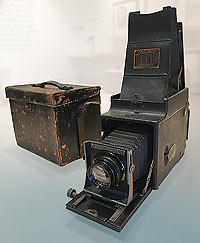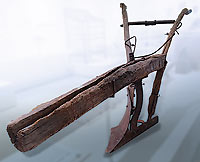MUSEUM HAPPENINGS - July 2020
How can an artifact tell a story?by Linn DeNesti, Communications, Moab Museum
 |
| 1916 Graflex 1134 Camera:In the 1950’s Mitch and Mary Williams started taking people out to what is now Canyonlands National Park in old jeeps. Some of the group’s members were Ed and Stella Law from California, Bill Hubel from Iowa, Bates and Tug Wilson, Paul Mayberry, and Lloyd and Marian Pierson. These trips helped lay the foundation of education and appreciation for this vast and beautiful place that became a national park in 1964. Ed Law, the owner of this Graflex camera, took many photographs that are currently part of the Museum archives today. |
The key to making these decisions is knowing everything possible about an object: What is it? Who made it? Where and why? What does it do? How did it get to the Museum? Who donated (or loaned) it … and why? Any object may be very interesting to look at, but without answers to many of these questions it’s hard to tell the bigger story: What role does (or did) the object play in someone’s life? Documenting an object’s origins, ownership, and purpose is the key practice of museum curators and is called provenance in museum-speak.
An object is far more interesting if it can inspire and inform a viewer when seen through the lens of its owner, but without detailed provenance it’s difficult for curators to exhibit an object with any impact. Stories in the Moab Museum’s new exhibit are made possible by object documentation (provenance) and the Museum’s legal right to display an object. This right is established through a Deed of Gift detailing parameters by which the Museum manages the object. These parameters may require the object to be exhibited but also may allow the object to be transferred to a more appropriate institution.
Decisions to accept the gift of an object are guided by policies that ensure the object fits the Museum’s exhibit and program needs and help to interpret the human experience in the region – and can be stored safely and economically. Without provenance and guiding policies, the Museum could become a very expensive community “attic” with thousands of orphaned objects. And, without a Deed of Gift the Museum would be ethically bound to care for objects indefinitely, regardless of cost.
In the process of developing our new exhibit experience, we’ve found many objects that can best be described as “lost treasures” without the sufficient provenance. But among those with great documentation are a 1916 Graflex 1134 Camera, Wooden Pack Saddle and Plow, and we’re pleased to showcase them here – and invite you to see them for yourselves when we reopen in a few months.
 |
| Wooden Pack Saddle and Plow: These items recovered by Kent and Fern Frost of Monticello in 1983 and donated to the Canyonlands National Park. Several other items were also donated but little information is known about them. An account of Kent Frost’s discoveries, an engaging and skilled storyteller himself, was never recorded and would have added a great deal to their story. That’s the gift of provenance. |
Support Moab Museum as it brings more objects and oral histories to life. Visit moabmuseum.org to explore the exhibits while we are physically closed and become a member today.
Moab Museum
Downtown Moab, 118 East Center Street
moabmuseum.org • 435-259-7985